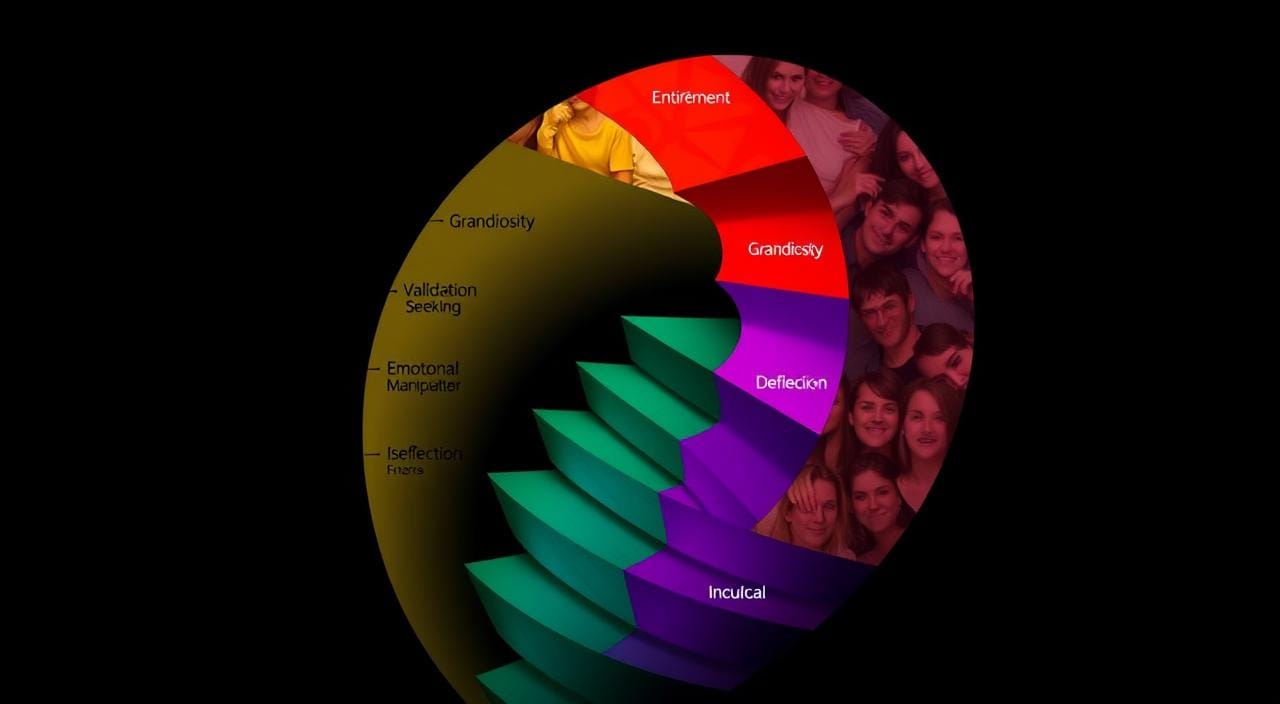Have you ever wondered why some relationships seem to be characterized by a constant power struggle, where one partner appears to hold all the control, while the other submits to their demands? The answer may lie in the intricate interplay between narcissism and codependency1. This dynamic, where a narcissist creates codependency in their partner, can be a recipe for a deeply dysfunctional and emotionally draining relationship. Learn how and why Narcissist Creates Codependency in Relationships?
Narcissists and codependents often find themselves drawn to one another, creating a symbiotic relationship where the narcissist’s need for admiration and control is met by the codependent’s desire to please and be needed2. This delicate balance, or rather, imbalance, can lead to a cycle of emotional manipulation, resentment, and a profound loss of individual identity.
Key Takeaways
- Narcissism and codependency often coexist in dysfunctional relationships, with the narcissist exerting control and the codependent seeking validation.
- Narcissists may hide behind a facade of self-sufficiency, while actually craving emotional closeness and intimacy1.
- Codependents struggle with setting healthy boundaries and tend to prioritize others’ needs over their own2.
- The attraction between codependents and narcissists is often rooted in their complementary needs and desires2.
- Recognizing the warning signs of these harmful patterns is the first step towards breaking the cycle and building healthier relationships.
Understanding Codependency
Codependency is a complex behavioral pattern that can significantly impact our relationships and overall well-being. At its core, codependency arises from an individual’s deep-seated need for approval, validation, and a sense of self-worth that is heavily tied to their relationships with others34. This creates a vicious cycle where codependents sacrifice their own needs and boundaries to cater to the desires of their partners, often in an effort to gain the attention, praise, and affection they so desperately crave34.
Codependent Behavior Patterns to Avoid
Individuals struggling with codependency may exhibit a range of concerning behavior patterns, including people-pleasing tendencies, a lack of personal boundaries, and a deep-rooted low self-esteem34. These behaviors often stem from a fear of abandonment and a desire to maintain control in their relationships, leading them to engage in enabling behaviors and take on a caretaker role, even at the expense of their own well-being34.
Lack of Boundaries and People-Pleasing Tendencies
Codependent individuals often struggle to establish and maintain healthy boundaries, blurring the lines between their own needs and those of their partners34. This can manifest in a constant desire to please others, even at the expense of their own happiness and self-care. Codependents may find it challenging to say “no” or to advocate for their own needs, leading to a cycle of resentment, burnout, and emotional exhaustion3.
| Codependent Behavior | Impact on Relationships |
|---|---|
| Lack of personal boundaries | Blurred lines between individual and partner’s needs, leading to emotional exhaustion |
| People-pleasing tendencies | Neglect of one’s own needs in an effort to gain approval and validation from others |
| Low self-esteem | Reliance on external sources for self-worth, creating an unhealthy dependence on relationships |
| Caretaking and enabling behaviors | Reinforcement of unhealthy patterns and a reluctance to let partners take responsibility for their actions |
By understanding the root causes and behavioral patterns associated with codependency, we can begin to recognize and address these unhealthy relationship dynamics, paving the way for more fulfilling and balanced connections34.
Recognizing Narcissism
Narcissism is a complex and often misunderstood personality trait characterized by an inflated sense of self-importance, a deep need for excessive attention and admiration, and a lack of empathy for others5. Those with narcissistic personality disorder (NPD) frequently display grandiosity, a sense of entitlement, and exploitative behavior, leading to dysfunctional relationships6.
Grandiosity and Sense of Entitlement
Individuals with narcissistic tendencies often exhibit an inflated sense of self-worth and a belief that they are superior to others6. This grandiosity can manifest in a constant need for validation, recognition, and admiration, with narcissists frequently feeling entitled to special treatment and privileges5.
Lack of Empathy and Exploitative Behavior
A hallmark of narcissism is a profound lack of empathy, where the narcissist struggles to understand or care about the emotions and needs of others5. This often leads to exploitative behavior, as narcissists may use manipulation and take advantage of people to fulfill their own desires without regard for the well-being of their partners or loved ones6.
The origins of narcissism are multifaceted, involving genetic, psychological, and environmental factors, with early childhood experiences and parenting styles playing a significant role in its development5. Understanding the nuances of narcissism is crucial in recognizing and addressing the challenges it poses within relationships7.
The Attraction: Why Codependents and Narcissists Gravitate Towards Each Other

The intricate relationship between codependents and narcissists is often described as a “dysfunctional dance,” where both parties engage in an unhealthy cycle of control and caretaking8. This dynamic arises from their complementary, yet fundamentally flawed, needs and motivations8.
Codependent individuals, who are commonly portrayed as sensitive, compassionate, and empathetic, often find themselves drawn to the confidence and charisma of narcissists8. The narcissist’s grandiose sense of self and constant demand for admiration can initially be mistaken for genuine love and connection, leading the codependent to overlook potential manipulations or emotional abuse9.
Conversely, narcissists may target codependent individuals, recognizing their craving for validation and affirmation8. The narcissist’s “love bombing” tactics, which involve excessive praise, admiration, and gifts, can draw in the codependent, who may interpret this intensity as a sign of true love9.
However, this initial attraction often morphs into a toxic and abusive dynamic, as the narcissist may resort to gaslighting, boundary testing, isolation, devaluation, and triangulation to assert control and create dependency in their partners9. The codependent, driven by their deep-seated insecurities and fear of abandonment, may continue to stay in these relationships, unable to break free from the cycle of control and manipulation9.
The emotional intensity of these relationships can be misleading, as codependents may interpret the narcissist’s attention and moments of affection as signs of genuine connection, overlooking the potential for emotional abuse and manipulation8. This complex interplay of needs and behaviors ultimately creates a dysfunctional dance that can be challenging to recognize and overcome8.
Complementary Needs and the Cycle of Control
At the heart of the attraction between codependents and narcissists lies the complementary nature of their needs and desires. Codependents, often shaped by childhood experiences where emotional expression was discouraged or parents were neglectful or abusive2, have a tendency to put others’ needs before their own. This makes them a seemingly perfect match for narcissists, who crave constant attention and admiration10. Codependents feel valued and purposeful by being able to care for or “fix” their narcissistic partners, often believing that this will earn them love and loyalty2. Conversely, narcissists are drawn to codependents because of their willingness to cater to their ego, needs, and desires while offering little in return2.
This dynamic creates a cycle of control and caretaking, where the narcissist’s demands and manipulation exploit the codependent’s fear of abandonment and desire for validation2. The emotional intensity in these relationships can be mistakenly perceived as true love or genuine connection, leading to confusion and overlooking manipulations or abuses10.
Codependent’s Need for Validation
Codependents often struggle with low self-esteem and seek validation from their partners due to their experiences in early childhood210. They believe that by catering to the narcissist’s needs, they will earn the love and loyalty they so desperately crave2.
Narcissist’s Constant Demand for Admiration
Narcissists, on the other hand, are characterized by an excessive sense of self-importance, a lack of empathy, and a constant need for admiration and attention10. They thrive on the codependent’s willingness to cater to their ego and desires, creating a dynamic where the cycle of control and caretaking is reinforced2.
| Codependent | Narcissist |
|---|---|
| Puts others’ needs before their own | Excessive sense of self-importance |
| Seeks validation and approval from partners | Lacks empathy and craves constant admiration |
| Believes caring for the narcissist will earn love and loyalty | Thrives on the codependent’s willingness to cater to their desires |
“The dance metaphor illustrates the cyclical nature of codependent-narcissist relationships, with partners oscillating between idealization, devaluation, and reconciliation.”10
This codependent-narcissist dynamic is often referred to as a “dysfunctional dance,” where the complementary needs of the two partners perpetuate a cycle of control and caretaking21011.
Narcissist Creates Codependency in Relationships
Narcissistic individuals often rely on others for their self-esteem and self-worth, with a tendency to feel down or depressed if they do not receive admiration and praise12. Conversely, codependent people have an excessive reliance on others for approval, a strong desire to please, and a tendency to sacrifice their own needs to take care of their partner12. This dynamic creates a symbiotic relationship where the codependent reinforces the narcissist’s sense of superiority, leading to a toxic and abusive dynamic over time.
A 2020 study on codependency revealed three significant themes within individuals with codependent tendencies: loss of sense of self, pattern of imbalance in social, occupational, and emotional aspects of life, and problems attributed to parental abandonment or control in childhood12. Narcissists, on the other hand, may devalue others in their relationships, need to feel superior, and display attention-seeking behaviors and exploitation of personal relationships12.
Folks with narcissistic traits often seek out people who constantly offer admiration and attention to avoid feeling abandoned12. Similarly, individuals with codependent behaviors tend to do more than they can handle for others, need recognition, and feel a pervasive pattern of anger12. This complementary dynamic, where both parties seek to fulfill their emotional needs, can lead to a dysfunctional relationship marked by control issues, emotional abuse, and a lack of healthy boundaries.
Setting healthy boundaries, seeking psychotherapy, and medication for any diagnosed conditions can help in balancing unhealthy codependent and narcissistic traits in relationships12. Additionally, support groups such as Codependents Anonymous and resources like Project Air offer education and peer support for managing these challenging dynamics12.
The Allure of Narcissists for Codependents
Narcissists often possess an alluring confidence and charisma that can be incredibly appealing to codependent individuals13. These narcissistic traits, combined with a tendency to “love bomb” their partners with excessive affection and admiration, can create a powerful attraction for codependents seeking validation and approval14.
Confidence and Charisma
Narcissists typically exude a sense of self-assurance and charm that can captivate codependent partners13. This perceived self-assuredness can be particularly alluring to those struggling with low self-esteem, as codependents often find themselves drawn to individuals who project an aura of strength and control14.
Love Bombing and Idealization
In the early stages of a relationship, narcissists frequently engage in a practice known as “love bombing,” showering their partners with intense affection, admiration, and attention14. This heightened level of affection can make codependent partners feel special and valued, feeding their need for validation and approval14. However, this idealization of the codependent partner often leads to unrealistic expectations and a subsequent devaluation and mistreatment14.
The combination of narcissistic confidence, charisma, and love bombing can create a powerful allure for codependent individuals, who may find themselves caught in a cycle of seeking validation and approval from their narcissistic partners1314. Breaking free from this dynamic requires a deep understanding of the underlying codependent and narcissistic traits that contribute to this unhealthy relationship pattern15.
The Dance Metaphor: Codependent-Narcissist Dynamic
The “dance metaphor” is a powerful way to illustrate the intricate and often destructive dynamic between codependents and narcissists in relationships. This metaphor portrays their interaction as a complex and intricately choreographed dance, with each partner playing a specific role and performing a set of well-rehearsed steps16.
At the heart of this dance lies the codependent-narcissist dynamic, where both parties validate and enable each other’s dysfunctional beliefs and behaviors. The codependent, yearning for validation and approval, is drawn to the narcissist’s confidence and charisma, while the narcissist’s insatiable need for admiration finds fulfillment in the codependent’s devotion1617.
This dance often begins with a phase of intense idealization, where the narcissist showers the codependent with affection and attention. However, as the relationship progresses, the narcissist inevitably shifts into a stage of devaluation, criticizing and belittling the codependent. The dance then enters a cycle of reconciliation, where the codependent desperately seeks to regain the narcissist’s approval, only to be met with further rejection and emotional abuse16.
Ultimately, the dance metaphor highlights the destructive nature of codependent-narcissist relationships, where each partner’s needs and behaviors contribute to the perpetuation of a toxic pattern1618. Breaking free from this dynamic can be incredibly challenging, but seeking professional help and engaging in personal growth can be transformative steps towards healthier relationships16.
How Relationships Between Codependents and Narcissists Turn Toxic
Codependents and narcissists are often drawn to one another, as both may feel they’ve found someone who can fulfill their unmet needs. Codependents often find themselves in relationships with narcissists, indicating a prevalence of such dynamics within certain circles19 However, this seemingly perfect match often turns toxic as the relationship progresses.
Lack of Clear Boundaries
Codependents typically have weak emotional and psychological boundaries, allowing narcissists to take advantage and further blur the lines between the two partners. Codependents struggle to establish emotional and psychological boundaries, leading to a cycle of enabling narcissistic behavior19. This lack of boundaries can make it challenging for codependents to recognize and address the manipulative and exploitative behavior of their narcissistic partners.
Devaluation and Emotional Abuse
After the initial “love bombing” phase, narcissists often shift from idealization to devaluation, criticizing, manipulating, and emotionally abusing the codependent partner. Narcissists exhibit behavior where they prioritize themselves over others, exploiting relationships without remorse19. This devaluation can be emotionally devastating to the codependent, who may struggle to understand what they did wrong to deserve this treatment and try even harder to regain the narcissist’s approval, perpetuating the toxic cycle.
Ultimately, the relationship between a codependent and a narcissist can become a complex and detrimental dynamic, where both partners struggle to break free and establish healthy boundaries. Partners of narcissists often experience confusion, hurt, and abandonment in the relationship19. However, with the right support and self-awareness, therapy can help codependents learn to set healthy boundaries and prioritize their own needs, leading to potential disengagement from the narcissistic relationship19.
Recognizing Dysfunctional Patterns
As codependent-narcissist relationships progress, the codependent individual often finds themselves struggling with low self-esteem and resentment2. Codependent individuals tend to have low self-esteem, struggle with setting boundaries, and prioritize the needs of others over their own2. Over time, the codependent may become increasingly resentful of the one-sided nature of the relationship, as the narcissist’s true manipulative and emotionally abusive nature emerges.
Low Self-Esteem and Resentment
As the narcissist begins to use emotional abuse and manipulation to maintain control, the codependent may feel hurt, confused, and desperate to regain the initial affection they felt2. Emotional intensity in relationships involving codependents and narcissists can lead to confusion and difficulty in recognizing manipulative or abusive behaviors10. The ongoing cycle of giving and sacrificing, paired with emotional abuse and manipulation, can lead to burnout for the codependent, who may experience physical and emotional exhaustion, a loss of self-identity, and a sense of hopelessness.
Caretaking and Enabling Behaviors
Codependency often arises from childhood experiences where emotional expression was discouraged or parents were absent, neglectful, or abusive2. The codependent’s fear of abandonment reinforces the narcissist’s sense of superiority, leading to a cycle of control and caretaking2. Codependents’ willingness to sacrifice their needs and well-being to meet those of the narcissist feeds the narcissist’s ego and sense of entitlement, contributing to more demanding and manipulative behavior10.
| Characteristic | Codependent | Narcissist |
|---|---|---|
| Self-Esteem | Low | Inflated |
| Boundaries | Weak | Poor |
| Empathy | High | Low |
| Motivation | Caretaking | Attention-seeking |
Recognizing these dysfunctional patterns is the first step towards breaking the cycle of codependency and narcissism in relationships. Take the quiz to assess your and start on the path to healthier, more fulfilling relationships2101.
Conclusion
The relationship between a narcissist and a codependent can be deeply complex and destructive. While the initial attraction may feel intoxicating, this dynamic quickly becomes a toxic pattern that can be incredibly challenging to break20. The grassroots term “codependence” emerged in the 1940s and was adopted by chemical dependence professionals as a valuable heuristic for labeling the pain of a dysfunctional relationship with an alcoholic/addict and an easily understandable reason for participating in mutual support 12 Step programs21. A study showed a significant correlation between narcissism and codependency, with most narcissists classified as codependent, while the reverse isn’t true.
It is essential for both partners to recognize the dysfunctional patterns and work towards establishing healthy boundaries, self-care, and an independent sense of self21. Codependency is a disorder of a “lost self” where individuals revolve their thinking and behavior around another person, substance, or process, while narcissists and codependents exhibit core symptoms of shame, denial, control, dependency, dysfunctional communication, and boundaries. With the right support and resources, it is possible to break free from this codependent-narcissist cycle and build more fulfilling, balanced relationships.
20 Narcissism and codependence have been linked through the myth of Narcissus and Echo, presenting a common dyadic relationship, where narcissists are proficient projectors while echoists are adept identifiers20. Karen Horney’s psychoanalytic terms outlined traits that align with codependence, and a serious study is encouraged on personality types susceptible to remaining in dysfunctional relationships with narcissistic alcoholics/addicts. By understanding the underlying dynamics and seeking the necessary support, individuals can take steps towards breaking free from these toxic patterns and establishing healthier, more balanced relationships.
FAQ
What is codependency and how does it contribute to dysfunctional relationships?
Codependency is a behavioral condition where an individual sacrifices their own needs and well-being to focus on the needs of another, leading to a pattern of relationships that are unbalanced and often unhealthy. Codependent individuals tend to have low self-esteem, have trouble setting boundaries, and ignore their own needs to satisfy others.
What are the characteristics of narcissism and how do they impact relationships?
Narcissism is characterized by an inflated sense of self-importance, a deep need for excessive attention, and a lack of empathy for others. Those with narcissistic personality disorder often display traits such as grandiosity, a constant need for admiration, and a lack of empathy, often leading to exploitative relationships.
Why are codependents and narcissists attracted to each other?
The attraction between codependents and narcissists arises from their complementary, yet fundamentally unhealthy, needs. Codependents, with their tendency to put others’ needs before their own, find a seemingly perfect match in narcissists, who crave attention and admiration. Conversely, narcissists are drawn to codependents because of their willingness to cater to their ego, needs, and desires while offering little in return.
How does the “dance metaphor” help explain the dynamics of a codependent-narcissist relationship?
The “dance metaphor” portrays the codependent-narcissist dynamic as a complex and choreographed dance that consists of specific steps and cycles. This metaphor highlights the destructive nature of these relationships, where each partner validates and enables the other’s dysfunctional beliefs and behaviors, oscillating among idealization, devaluation, and reconciliation.
What are the signs that a codependent-narcissist relationship is turning toxic?
As the relationship progresses, the narcissist’s true nature often emerges, and they begin using manipulation and emotional abuse to maintain control. The codependent may feel hurt, confused, and desperate to regain the initial affection, leading to a cycle of giving and sacrificing, paired with emotional abuse and manipulation, which can result in burnout and a loss of self-identity.
How can individuals in a codependent-narcissist relationship break free from the toxic patterns?
It is essential for both partners to recognize the dysfunctional patterns and work towards establishing healthy boundaries, self-care, and an independent sense of self. With the right support and resources, it is possible to break free from this codependent-narcissist cycle and build more fulfilling, balanced relationships.
Source Links
- Narcissists Are Codependent, Too – https://www.psychologytoday.com/us/blog/toxic-relationships/201907/narcissists-are-codependent-too
- The Overlap Between Codependency and Narcissism in Relationships – Start My Wellness, Ferndale, MI – https://startmywellness.com/2024/03/codependency-and-narcissism-in-relationships/
- Understanding The Dynamics of Narcissist and Codependent Relationships – https://somabrain.com/en/the-mindset/exploring-the-dynamics-of-narcissist-and-codependent-relationships-understanding-codependency-and-narcissism
- Understanding a Codependent Narcissist | Tacoma Christian Counseling – https://tacomachristiancounseling.com/articles/understanding-a-codependent-narcissist
- How Codependency And Narcissism Are Connected (& Why It Matters) – https://www.linkedin.com/pulse/how-codependency-narcissism-connected-why-matters-kamini-wood-wzaxe
- Narcissist vs Codependent: Contrasting Toxic Relationships — Judge Anthony – https://www.judgeanthony.com/blog/narcissist-vs-codependent
- The Narcissistic Codependent Marriage – Learn the Signs – https://thencmarriage.com/
- The Real Reason Narcissists and Codependents Attract Each Other – Dr Laura Berman – https://drlauraberman.com/the-real-reason-narcissists-and-codependents-attract-each-other/
- Narcissists and codependents: Part 2 – How their relationships turn toxic – https://www.talkingmentalhealth.com/post/narcissists-codependents-how-their-relationships-turn-toxic
- Narcissist And Codependent Compatibility In Relationships – https://www.simplypsychology.org/the-dance-between-codependents-narcissists.html
- The Relationship Between Narcissism And Codependency – https://www.mentalhelp.net/blogs/the-relationship-between-narcissism-and-codependency/
- Narcissist and Codependent Compatibility in Relationships – https://psychcentral.com/disorders/the-dance-between-codependents-narcissists
- Confused About Love | The Natural Attraction Between Codependents and Narcissists – https://confusedaboutlove.com/the-natural-attraction-between-codependents-and-narcissists/
- Why Codependents Are Overly Attracted To Narcissists – https://ramelize.medium.com/why-codependents-are-overly-attracted-to-narcissists-a1c526730da9
- The dance between codependents and narcissists – Counseling Today Archive – https://ctarchive.counseling.org/2014/03/the-dance-between-codependents-and-narcissists/
- The Dance of Codependency – https://kripalu.org/resources/dance-codependency
- The Narcissist And Co-dependent – Two Sides Of The Same Coin – https://blog.melanietoniaevans.com/the-narcissist-and-co-dependent-two-sides-of-the-same-coin/
- – Therapy Ideas – https://www.therapyideas.net/details/codependency-lets-think-about-it-as-self-love-deficiency-episode-68/
- Breaking The Bond Between Narcissist And Codependent – https://theonlinetherapist.blog/breaking-the-bond-between-narcissist-and-codependent/
- Codependence and Narcissism Are Two Ends of a Continuum – https://www.psychologytoday.com/us/blog/healing-addiction/202202/codependence-and-narcissism-are-two-ends-continuum
- Narcissists are Codependents, Too | What Is Codependency? – https://whatiscodependency.com/narcissists-are-codependents-too/







